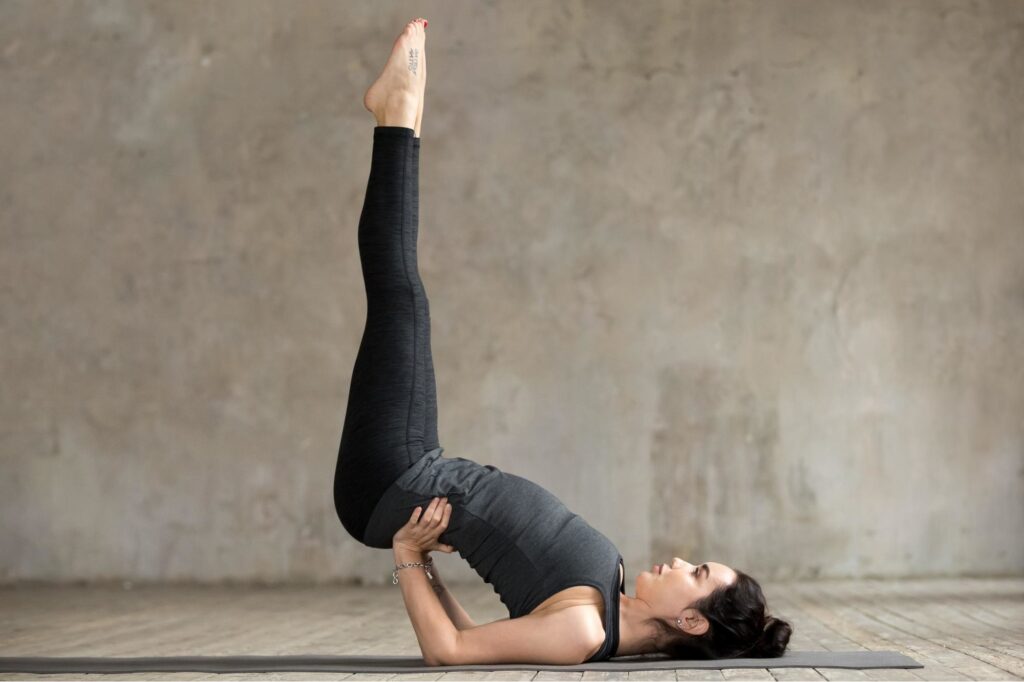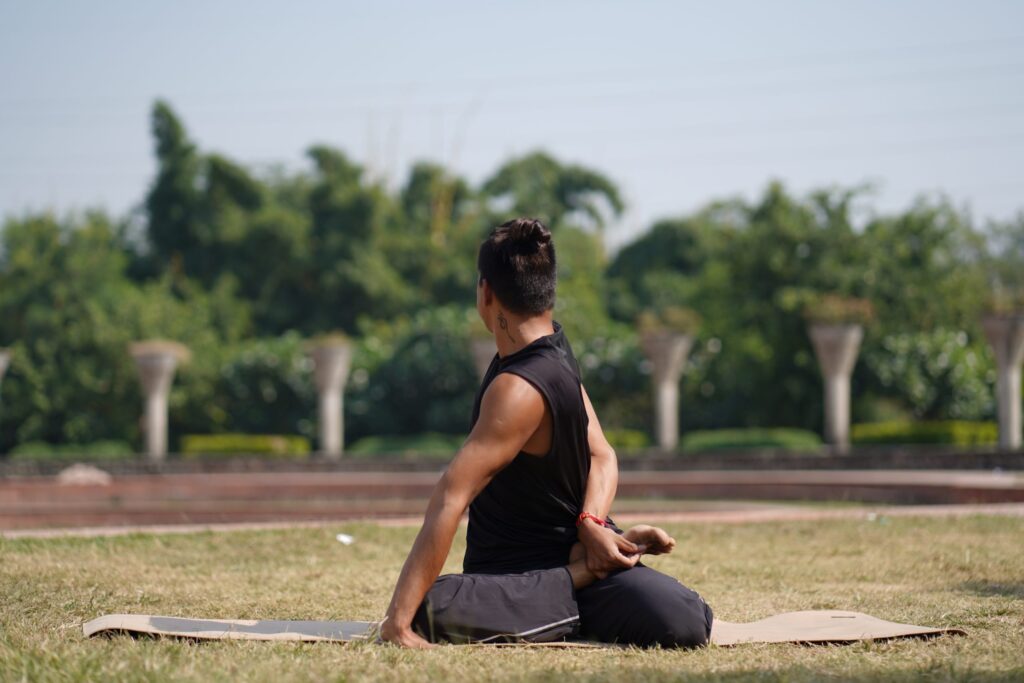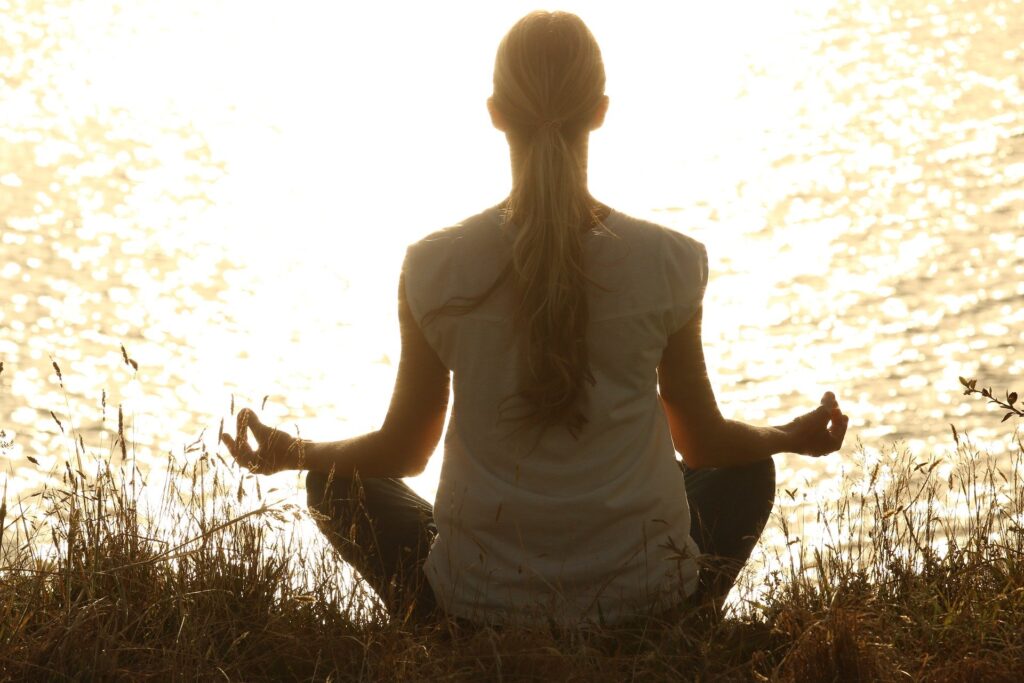Viparita Karani ( विपरीतकरणी ) is an inversion pose also known as – Legs Up The Wall Pose or Inverted Lake Pose. This asana is a part of Hatha Yoga that promotes a healthy mind-body coordination and offers powerful anti-aging effects on the body. Here, we will discuss various such benefits, steps and precautions for performing Viparita karani.
The name Viparita Karani Asana comes from three Sanskrit words – Viparita ( विपरीत ) meaning ‘inverted‘ or ‘reversed‘, Karani ( करणी ) which means ‘doing’ or ‘making’, and ‘asana’ ( आसन )– ‘posture or seat’. In this asana, one need to lie down on the floor near a wall with closed eyes, arms resting on floor and raising legs up the walls at 90° angle.
Viparita Karani pose is well-documented in the ancient text, Vivekamartanda that describes its practice as a means to Pratyahara ( yogic withdrawal ) and Dhyana ( meditation ) – two important components of the Ashtanga or eight limbs of yoga. The practice of this inversion pose aids mind to enter into a deep state of meditation and self–awareness.
Viparita karani is a restorative pose that offers calming and nourishing effects on mind and the body. It is easier to hold for extended periods of time than any other inversion poses like Sarvangasana or Sirsasana. According to old Hindu scriptures, the practice of Viparita Karani would not only reduce wrinkles but also keeps old age & death away.
How to do the Legs Up the Wall Pose ( Viparita Karani )
It’s really important to know the correct alignment of the body for Viparita Karani to attain the maximum benefits. So, following is the step-by-step guide to do Viparita Karani ( Legs Up the Wall Pose )
Step 1 :
Start the pose by setting near a wall with some cozy space. And lie down on your back keeping the hands resting next to your hips.
Step 2 :
Bring hips closer to the wall and raise your legs up the wall bending from the hip level. Make sure legs are perpendicular to the floor.
Step 3 :
Afterwards, breathe normally and press the back of your legs against the surface of wall while your soles of the feet pointing upwards.
Step 4 :
You may use your elbows and hands to raise up your lower back & trunk. Moreover, You can also place a pillow underneath your head.
Step 5 :
Settle down in this posture with closed eyes and relax your body. Breath deeply and maintain the pose at least for 10–15 minutes.
Step 6 :
To come out of this asana, bend your knees near the chest and push your body to one side. Breathe normally as you sit up and relax.
Modifications & Variations
Following are some common props that would be helpful and supportive for beginners who can’t hold Viparita Karani for a few minutes.
1. To get relief from sacrum pain
- You may use a yoga bolster, block, cushion or a folded blanket under your hips so that your sacrum is fully supported by the props.
2. If you feel strain in your legs
- You can use yoga strap to make a large loop & slip it around the legs. Thus you can stretch them out & press into the strap for support.
3. Support to shoulders & thighs
- You can place folded blanket under your shoulders and a strap around your thighs or calf muscles. This would allow you to relax more.
4. In case the legs are unsteady
- Just push the wall with your feet gently and slide your upper body away from the wall in a manner your pelvis can touch the ground.
5. Different positioning of arms
- You may simply keep arms along your sides or straight out to your sides with your palms up or Cactus arms — upper arms straight out from shoulders, palms on belly.
Precautions And Contraindications of Viparita Karani Mudra
Keep the following points of caution in your mind before you start the practice Viparita Karani Mudra. The major areas of concerns are : –
- Viparita Karani asana acts as a form of mild inversion, so women should avoid its practice during their pregnancy & menstruation.
- People with serious back and neck problems, should perform this yoga asana under the guidance of a professional yoga instructor.
- If you feel tingling in your feet while practicing this asana, bend your knees and touch soles, it brings your heels close to the pelvis.
- Avoid this asana if you’re suffering from severe eye problems like glaucoma, high blood pressure, heart diseases or thyroid disorders.
- People who are suffering from hiatus hernia or have any injuries on hip, spine and knees, should avoid the practice of this yoga pose.
Health benefits of Viparita Karani ( Legs Up the Wall pose )
Viparita Karani ( Legs Up the Wall pose ) is an inverted pose that can offer a range of health benefits.
1. Relax your Mind
- The practice of Viparita Karani asana ( Legs up the wall pose ) is a relaxing pose that helps to calm your mind and nervous system.
- This pose involves deep breathing that aids to lower the anxiety & stress levels. Plus, it provides relief from migraine and headache.
2. Promotes Blood Flow
- The Viparita karani mudra helps to increase blood circulation throughout the body and raise the venous blood drainage as well.
- A study suggests the practice of this asana strengthens the heart muscle, better blood flow and reduce the risk of heart diseases.
3. Relieves mild pain
- Viparita Karani relieves lower back pain and soothes your abdominal muscles. It alleviates tension from hips, neck and shoulders.
- Moreover, this inverting pose also relieves varicose veins, swollen ankles and feet (edema) due to pregnancy, travel, running etc.
4. Improves your digestion
- Practice of this asana helps to improve your appetite, increase the secretions of digestive juices and metabolism in the body cells.
- Viparita Karani brings fresh blood and lymph fluids to abdomen that help to improves digestion and tones the abdominal muscles.
5. Helps to Relieve Fatigue
- The Legs up the wall pose restores your tired or cramped feet and legs muscles after a run, flight, long walk, hike or bike ride.
- Plus, the practice of Viparita Karani yoga mudra may also be effective in removing any strain, pain or numbness due to sciatica.
6. Relieves Menstrual Cramps
- A case study suggest that Viparita Karani can help in alleviating menstrual cramps, menopause and premenstrual syndrome.
- This pose may relax your abdomen and lower back, however some experts advice to avoid its practice during menstruation.
7. Stretches and Tones Muscles
- A research study suggests that the practice of viparitakarani asana can help people with obesity to reduce fat around the waist.
- It prevents atherosclerosis and gives good stretch to front of the torso, back of the legs, neck, glutes, hip adductors, calves, pelvis.
8. Balanced hormonal system
- Viparita Karani activates vishuddhi chakra (near neck) that provides you the ability to better express your creativity and emotions.
- This asana can has the positive impact on the functioning of your thyroid and endocrine glands. Plus, it regulates hypothyroidism.
Also Read :
9. Strengthened immune system
- Legs up the wall pose keeps you young and vital, boosts energy levels, promote body balance and improves your immune system.
- This may also treats hydrocele, piles, constipation, hernia, testicular, semen, and ovarian problems in men and women respectively.
Also Read :
10. Improves Quality of Sleep
- Practice of Viparita Karani helps to improve the quality of sleep and may relieves the symptoms of mild depression and insomnia.
- A research study suggests 10 minutes practice of viparita Karni can reduce your stress significantly. Hence, it promotes good sleep.
Also Read :
11. An Anti- Aging Exercise
- According to Hatha Yoga Pradipika (3.82), 6 months practice of Viparita Karani can reduce signs of aging like grey hairs & wrinkles.
- As per kriya yoga, Viparita Karani promote anti-aging by reversing the flow of nectar from Manipura chakra (navel) back to third eye.
Also Read :
Preparatory Poses
- Virasana
- Uttanasana
- Supta Baddha Konasana
- Setu Bandha Sarvangasana
- Parivrtta Sukhasana
- Vajrasana
- Indudalasana
- Paschimottanasana
Follow-up poses
- Pranayama
- Shavasana
- Setu Bandha Sarvangasana
- Supta Virasana
- Savasana
- Supta Padangusthasana
- Supta Dwi Hasta Padasana
- Hanumanasana
- Adho Mukha Vrksasana
Tips for performing Viparitakarani Mudra
- Make sure your bowels are empty before you start doing Viparita karani and maintain a gap of 6 hours between your meal & practice.
- Though Viparita karani is usually performed before Shavasana.but you may practice it independently besides your regular yoga routine.
- In order to avoid any kind of injuries, make sure that you practice Viparita Karani under the supervision of a certified yoga instructor.
- To increase the stretch in the groin and the thighs, you can spread your legs in a wide ‘V’- shape when you rest them against the wall.
- The best time to perform this mudra is both morning & evening on an empty stomach. Plus, There is no warm up needed for the pose.
- Concentrate on your Manipura chakra and Vishudhi chakra every time you breathe in. Long exhalations calm down nervous system.
- Furthermore, a beginners may start doing Legs up the wall pose for 5 minutes. With practice one can increase hold timing for 3 hours.
Conclusion
Viparita Karani is a super accessible and rejuvenating pose. This pose is a type of kaya yoga mudra that involves whole body with deep breathing. This inversion pose reverses flow of Soma ( nectar ) back to Agya Chakra.
The practice of Viparita Karani along with Ujjayi breathing and khechari mudra provides you complete relaxation. So, next time when you are feeling stressed, do lift your legs up the wall instead of putting them in the couch.
Also Read
FAQs Related to Viparita Karani Mudra & its benefits
Is lifting legs up the wall during Viparita Karani really provide any health benefits ?
Viparita Karani is simple yet wonderful exercise that offers many therapeutic benefits. It not only reduces backache, hamstrings, stiffness of muscles but also relives arthritis, migraines, hemorrhoids respiratory ailments and urinary disorders. The increased blood flow to brain may cure cerebral insufficiency and dementia.
Why do pregnant women should avoid the practice of Viparita karani ?
Pregnant women should avoid doing inversion pose like Viparita Karani because when you lie on your back during pregnancy, there would be unnecessary pressure on the vena cava.
Do really Viparita Karani really helpful in relieving fatigue ?
When you place your legs up the wall, the lymph and other fluids that may lead to swollen ankles, tired knees and congested pelvic organs flow into your belly. This reverse flow of fluids refresh your legs and reproductive organs. If you feel stressed or fatigued, you should try this inversion pose.
What is the difference between Viparita Karani and Sarvangasana ?
Unlike Sarvangasana, in Viparita Karani pose, the back is not completely straight rather tilted at 45°-60° angles. This mudra is also known as half shoulder stand because your shoulders and throat muscles don’t bear that much pressure like Sarvangasana. It is believed that this pose direct the Kundalini in upward direction.




